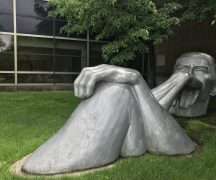By DAVID DUPONT
BG Independent News
In the language of the Metis one word refers both to ancestors and descendants. The word means both great-grandparents and great-grandchildren.
For indigenous people the past, present, and future are not a continuum but ever present, said Dylan Miner, an artist, activist, scholar and educator from Michigan. “All are intimately connected in a being that is myself,” he said. And all that’s connected in the art he creates.
Miner, who teaches at Michigan State, was the guest for the opening talk in the Homelands and Histories Speaker Series presented by the Institute for the Study of Culture and Society at Bowling Green State University. He spoke Tuesday at the Wood County District Public Library.
Miner’s art is deeply rooted both in the history of indigenous peoples and their current struggles, which are fought to secure the future. Miner is Metis on his father’s side. The Metis are a people that trace their ancestry back to the descendants of indigenous people and French and English fur traders. Miner’s people lived on Drummond Island until removed. The land of the Metis stretches from the Georgian Bay to through western Canada, straddling the border with the United States.
The Metis language, Michif, is a mix of French nouns and Cree verbs and grammar. Miner introduced himself in Michif and then in Ojibway, which he learned from Ojibway elders living in Lansing.
The first art work Miner discussed was a fire bag, called colloquially an “octopus bag,” which his grandfather’s grandmother had, and which still remains in his family. It was used to carry the herbs for medicine.
Miner continues to use natural materials for some of his own art. In a piece celebrating Louis Riel, a Metis who led two insurrections against the fledgling Canadian government in the late-19th century, Miner altered archival photos by covering Riel’s image in birch bark.
The legal systems that ended in the executions of Riel in Canada or 38 Dakota men in Minnesota in 1862, the largest mass execution in U.S. history, persist to this day, he said.
It was around 1862, Miner noted, that his Scandinavian ancestors on his mother’s side arrived in the Midwest, availing themselves of free land offered by the government. Pointing out a photo of his ancestor’s farm, he said: “Even when individuals are not actually participating in a system of mass violence, the benefits are passed to them.”
In 2015, 110 years after his grandfather’s grandfather was arrested for poaching when he went to harvest a deer on traditional tribal land, Miner recreated that landscape using copper pipe, drawings of constellations each with 110 stars, 110 copies of the arrest documents, and deer antlers. “The material is important to me in its relationship between me and the history, the stories, the land.”
The work, in part, reflects the mix emotions about pipelines. His great-grandfather was one of the first to come to the city, where he worked as a pipefitter.
There are “beautiful pipelines,” Miner said. Metaphorical pipelines, he said, bring students of color and first generation students to the university. And the copper pipes like those he used in the installation bring water into homes. “Then there are the pipes that are smoked in many indigenous communities as a way of connecting with the creator and the ceremony.”
Then there are “the violent pipelines,” he said, “that crack, and break and spill fossil fuel.” Miner has created linoleum and wood-block prints protesting those pipelines. These were drawn, cut and pulled quickly, within an hour, raw images depicting pipelines as evil snakes. These prints and the t-shirts made from them are often given away or sold to benefit those trying to stop the Dakota Access Petroleum Pipeline.
Miner said new pipelines are only part of the problem. “We have to be concerned about those that have been here for a very, very long time” such as Enbridge Line 5.
Line 5 was constructed in 1953 and has had 29 breaks since 1965, when officials started keeping track. It has spilled an estimated 1.1 million gallons of tar sands oil. It runs from western Canada to Sarnia, Ontario, cutting through part of Wisconsin and across Michigan’s Upper Peninsula. The pipeline runs under the Straits of Mackinac.
A spill in the straits would be disastrous, Miner said. “This is a very sacred space and an ecologically important space.” The impact tourism would also be an economic disaster.
Miner sees the struggles of indigenous people linked to those of others. The shooting death in Saskatchewan of Colten Boushie by a white farmer Gerald Stanley, who was acquitted of shooting the young man three times in the back of the head, represented the same kind of violence visited on African-Americans, Latinos, immigrants, and Muslims. Miner finds it ironic that those who benefited from taking others’ land now fight to keep other people out. He displayed a print made in response to the Trump order to restrict immigrants and refugees: “No bans on stolen lands.”
Early in his talk, Miner noted that the Cree call the Metis “the people without bosses.”
“I take that very seriously in terms of the work I do … to dismantle systems of hierarchy in all their forms.”





